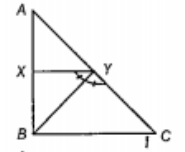In a ΔABC, a line PQ parallel to BC cuts AB at P and AC at Q. If BQ bisects ∠PQC, then which one of the following relation is always true :
BC=CQ
BC=BQ
BC≠CQ
BC≠BQ
The correct Answer is:A
To solve the problem, we will analyze the given triangle ΔABC and the line PQ that is parallel to BC. We will also use the information that BQ bisects ∠PQC.
1. Draw Triangle ABC:
Start by sketching triangle ABC with vertices A, B, and C.
Hint: Label the vertices clearly to avoid confusion later.
2. Draw Line PQ Parallel to BC:
Draw line PQ such that it is parallel to side BC of triangle ABC. Mark the intersection points where PQ meets AB at point P and AC at point Q.
Hint: Remember that parallel lines create corresponding angles that are equal.
3. Identify Angles:
Since BQ bisects ∠PQC, let ∠PQB=θ and ∠QBC=θ as well. Therefore, ∠PQC=2θ.
Hint: Use the property of angle bisectors to set up relationships between the angles.
4. Use Alternate Interior Angles:
Because PQ is parallel to BC, we can say that ∠QBC=∠PQC. Thus, ∠QBC=θ.
Hint: Recall that alternate interior angles are equal when two lines are parallel.
5. Establish Isosceles Triangle:
Since ∠PQB=θ and ∠QBC=θ, triangle BQC is isosceles with BQ=BC.
Hint: In an isosceles triangle, the angles opposite to equal sides are equal.
6. Conclude the Relationship:
From the isosceles triangle BQC, we can conclude that BC=CQ.
Hint: This conclusion is based on the properties of isosceles triangles.
7. Choose the Correct Option:
Among the options provided, the correct relationship that is always true is BC=CQ.
Hint: Verify that this conclusion aligns with the options given in the problem.
Final Answer:
The relation that is always true is BC=CQ.
Start by sketching triangle ABC with vertices A, B, and C.
Draw line PQ such that it is parallel to side BC of triangle ABC. Mark the intersection points where PQ meets AB at point P and AC at point Q.
Since BQ bisects ∠PQC, let ∠PQB=θ and ∠QBC=θ as well. Therefore, ∠PQC=2θ.
Because PQ is parallel to BC, we can say that ∠QBC=∠PQC. Thus, ∠QBC=θ.
Since ∠PQB=θ and ∠QBC=θ, triangle BQC is isosceles with BQ=BC.
From the isosceles triangle BQC, we can conclude that BC=CQ.
Among the options provided, the correct relationship that is always true is BC=CQ.
The relation that is always true is BC=CQ.
Topper's Solved these Questions
- BOOK - ARIHANT SSCCHAPTER - GEOMETRYEXERCISE - INTRODUCTORY EXERCISE - 12.328videos
GEOMETRY
- BOOK - ARIHANT SSCCHAPTER - GEOMETRYEXERCISE - INTRODUCTORY EXERCISE - 12.410videos
GEOMETRY
- BOOK - ARIHANT SSCCHAPTER - GEOMETRYEXERCISE - INTRODUCTORY EXERCISE - 12.145videos
GEOMETRY
- BOOK - ARIHANT SSCCHAPTER - FUNDAMENTALS EXERCISE - TEST OF YOU - LEARNING - 240videos
FUNDAMENTALS
- BOOK - ARIHANT SSCCHAPTER - HCF AND LCMEXERCISE - Exercise Higher Skill Level Questions18videos
HCF AND LCM
Similar Questions
Knowledge Check
- Question 1 - Select One
In a ΔABC, a line PQ parallel to BC cuts AB at P and AC at Q. If BQ bisects ∠PQC, then which one of the following relation is always true :
ABC= CQBBC=BQCBC≠CQDBC≠BQ - Question 2 - Select One
If the perimeter of a semi-circular protractor is 36cm, then its diameter is?
Aa. 6cmBb. 7cmCc. 7.5cmDd. 14cm - Question 3 - Select One
If AB, BC and AC be the three sides of a triangle ABC, then which one of the following is true?
AAB−BC=ACB(AB−BC)>ACC(AB−BA)<ACDAB2−BC2=AC2
In ΔABC, point D is on BC such that ∠BAD=∠ACD. If AB=9cm,AD=8cm,AC=12 cmthen which of the following is true ?
View SolutionIn ΔABC, PQ is parallel to BC, while P and Q are at AB and AC respectively. If AB = 3AP, then what is the ratio of areas of triangles ΔAPQ and ΔABC.
View SolutionIn a triangle ABC, if AB,BC and AC are the three sides of the triangle, then which of the statements is necessarily?
View SolutionIn ΔABC, the line parallel to BC Intersects AB and AC at P and Q respectively. If AB:AP=5:3then AQ:QCis :
View SolutionIn ΔABC,∠C=2∠A and AC=2BC. Then which of the following is/are True ?
View Solution


